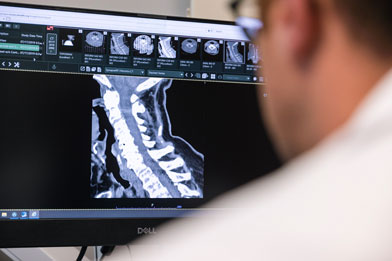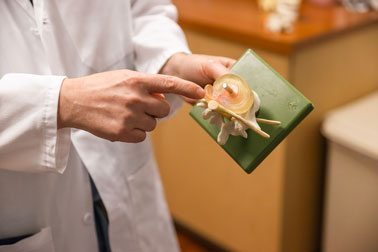Spine Condition Specialists
Neurosurgical Care Powered By Decades of Experience
Living with a complex spine condition is difficult, but finding the right treatment option isn’t. We work closely with you to develop personalized treatment plans that actually make the difference.
Specialty Focus on Complex Spine Conditions

Your long-term relief is important to us. Through the latest advancements in surgical technology and personalized treatment plans, our team successfully corrects a multitude of degenerative spine conditions and diseases.
Receive The Best Treatment Possible For:
Herniated Disc (Lumbar and Cervical)
A herniated disc is a problem that occurs in the lower back or neck. It occurs when the soft center of a spinal disc is pushed through a crack in the exterior casing. When the portion of the disc is pushed through the crack, this is the herniated disc. Often, a herniated disc can pinch a spinal nerve, which causes neck or back pain and this pain may radiate through your extremities.
This problem can be caused by lifting an object that is too heavy or without proper form. It can also result from other spinal conditions like degenerative disc disease and osteoarthritis.
Symptoms
- Pain in the neck of lower back
- Weakness in the hands or feet
- Numbness in the hands or feet
- Burning in the hands or feet
Symptoms can range from mild to severe. It is important if you have these symptoms to come into Elite Brain and Spine so our spine specialists can help your pain.
Treatment
There is usually no surgery necessary to treat herniated discs. Options such as non-steroidal anti-inflammatory drugs, activity modification, physical therapy and injections should help. However, if these options do not help, your Elite Brain and Spine specialist may suggest a minimally invasive spine surgery to help. Our spine specialists are experts when it comes to herniated discs.
Cervical Myelopathy
Cervical Myelopathy occurs when the spinal cord is compressed by a spinal disc or a piece of bone in the spine. In the cervical spine, there are seven vertebrae with nerves that extend outward and each vertebra is cushioned by these spinal discs.
It usually occurs due to degenerative changes to the spinal discs or joints. Specifically, degenerative disc disease and arthritis can cause cervical myelopathy. However, in some cases, it can be caused by a sudden impact to the neck such as a car accident.
Symptoms
- Neck pain
- Weakness in the arms, hands, and fingers
- Tingling in the arms, hands, or fingers
- Difficulty grasping objects
- Loss of balance or motor skills
These symptoms can vary from person to person. They may appear over time and become more frequent.
Treatment
To reduce the pain, our spine specialists have to reduce the pressure on the spinal cord and nerves. Therefore, in some cases, our spine specialists can alleviate pain non-surgically. These options include:
- A cervical brace
- Physical therapy
- Nonsteroidal anti-inflammatory drugs (NSAIDs)
- Corticosteroids
- Epidural steroid injections
If these non-surgical options do not work, your spine specialist may suggest a surgical procedure to reduce the pressure in the spinal cord and nerves. The surgical procedures are minimally invasive and can include a cervical spinal fusion or a laminectomy.
Cervical Radiculopathy
Cervical radiculopathy is not a diagnosis, but a term used to describe a pain that develops in the neck but flows into the shoulders, arms, or fingers. This pain is a symptom of an underlying condition that is compressing a nerve in the cervical spine. Underlying conditions may include herniated discs, spinal stenosis, spinal arthritis, degenerative disc disease, and spinal bone spurs.
Symptoms
- Neck pain
- Pain in the shoulders, arms, or fingers
- Weakness in the shoulders, arms, or fingers
- Numbness or tingling in the shoulders, arms, or fingers
Treatment
Treatment for cervical radiculopathy is usually non-surgical. Here at Elite Brain and Spine, your specialist may use a combination of these treatment options to help with cervical radiculopathy:
- Non-steroidal anti-inflammatory medications
- Physical therapy
- Injections
In some instances, surgery may be suggested if your pain does not go away with non-surgical treatment options. At Elite Brain and Spine, all of the spine specialists are top rate and are experts in treating patients with cervical radiculopathy.
Degenerative Disc Disease
Degenerative disc disease is an age-related disease where the discs between the vertebrae lose cushioning, fragmentation and herniation. In some cases, osteoarthritis and spinal stenosis may develop. Any of the discs can degenerate, however the discs in the lower back and neck are usually the ones that are affected.
Symptoms
Sometimes degenerative disc disease in its early stages does not show symptoms. However, as the disease progresses, symptoms do appear which include:
- Pain in the neck or back
- Pain that radiates into the extremities
- Feeling of stiffness in the neck or back
- Pain in the back that is made better by sitting or standing
Delaying treatment could cause these symptoms to become worse.
Treatment
Usually, Degenerative disc disease can be treated non-surgically with treatment option such as:
- Non-steroidal anti-inflammatory drugs (NSAIDs)
- Physical therapy
- Activity modification
- Injections
If you are experiencing any of the symptoms above, it is important to make an appointment today at Elite Brain and Spine to have one of our spine specialists help with these treatment options. All of our top specialists are experts when it comes to treating degenerative disc disease. Although degenerative disc disease does not require surgery itself, if you develop osteoarthritis, spinal stenosis or other conditions you may need surgery.
Want to Understand More About Your Diagnosis?
Minimally Invasive Techniques For Long-Term Relief

At Elite Brain and Spine of Connecticut our approach is always to relieve you from pain, significantly reduce the risks associated with surgery and minimize recovery time. Our team is highly-skilled and backed by decades of experience in various areas of minimally invasive procedures for brain surgery, stereotactic radiosurgery, cranioplasties, neuro-oncology, and skull base surgery.
Our Surgical Experience Includes:
- Craniotomy
- Cranioplasty
- Microvascular Decompression
- Stereotactic Biopsy
- Subdural Hematoma Embolization

Hear From Our Patients
About Elite Brain & Spine of Connecticut

You are in extremely experienced and compassionate hands with the neurosurgical associates at Elite Brain & Spine of Connecticut. With locations in Danbury and Norwalk, expert care is close by.

Request an Appointment
Locations in:
– Norwalk
– Danbury
Give Us A Call:
Danbury: 203-792-2003
Norwalk: 203-853-0003